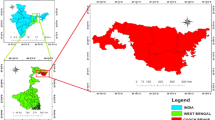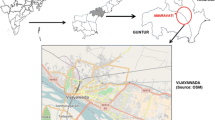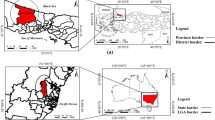Abstract
It is well known and witnessed the fact that in recent years the growth of urbanization and increasing urban population in the cities, particularly in develo** countries, are the primary concern for urban planners and other environmental professionals. The present study deals with multi-temporal satellite data along with statistical models to map and monitor the LULC change patterns and prediction of urban expansion in the upcoming years for one of the important cities of Ganga alluvial Plain. With the help of our study, we also tried to portray the impact of urban sprawl on the natural environment. The long-term LULC and urban spatial change modelling was carried out using Landsat satellite data from 2001 to 2016. The assessment of the outcome showed that increase in urban built-up areas favoured a substantial decline in the agricultural land and rural built-up areas, from 2001 to 2016. Shannon’s entropy index was also used to measure the spatial growth patterns over the period of time in the study area based on the land-use change statistics. Prediction of the future land-use growth of the study area for 2019, 2022 and 2031 was carried out using artificial neural network method through Quantum GIS software. Results of the simulation model revealed that 14.7% of urban built-up areas will increase by 2019, 15.7% by 2022 and 18.68% by 2031. The observation received from the present study based on the long-term classification of satellite data, statistical methods and field survey indicates that the predicted LULC map of the area will be precious information for policy and decision-makers for sustainable urban development and natural resource management in the area for food and water security.










Similar content being viewed by others
References
Anderson, J. R. (1976). In: A land use and land cover classification system for use with remote sensor data, vol. 964. US Government Printing Office, Washington, DC (pp. 1–26) Geological Survey Professional Paper.
Belal, A. A., & Moghanm, F. S. (2011). Detecting urban growth using remote sensing and GIS techniques in Al Gharbiya governorate, Egypt. The Egyptian Journal of Remote Sensing and Space Science,14(2), 73–79.
Bhatta, B., Saraswati, S., & Bandyopadhyay, D. (2009). Quantifying the degree-of-freedom, degree-of-sprawl, and degree-of-goodness of urban growth from remote sensing data. Applied Geography,30(1), 96–111.
Buiton, P. J. (1994). A vision for equitable land use allocation. Land Use Policy,12(1), 63–68.
Burgess, R., & Jenks, M. (Eds.). (2002). Compact cities: Sustainable urban forms for develo** countries. Abingdon: Routledge.
Butt, A., Shabbir, R., Ahmad, S. S., & Aziz, N. (2015). Land use change map** and analysis using remote sensing and GIS: A case study of Simly watershed, Islamabad, Pakistan. The Egyptian Journal of Remote Sensing and Space Science,18(2), 251–259.
Castella, J. C., & Verburg, P. H. (2007). Combination of process-oriented and pattern-oriented models of land-use change in a mountain area of Vietnam. Ecological Modelling,202, 410–420.
Census of India. (2011). Provisional population totals. Paper no. 2, Registrar General, New Delhi, India.
Cetin, M. (2015a). Determining the bioclimatic comfort in Kastamonu City. Environmental Monitoring and Assessment,187(10), 640. https://doi.org/10.1007/s10661-015-4861-3.
Cetin, M. (2015b). Evaluation of the sustainable tourism potential of a protected area for landscape planning: A case study of the ancient city of Pompeipolis in Kastamonu. International Journal of Sustainable Development and World Ecology,22(6), 490–495.
Cetin, M. (2015c). Using GIS analysis to assess urban green space in terms of accessibility: Case study in Kutahya. International Journal of Sustainable Development and World Ecology,22(5), 420–424. https://doi.org/10.1080/13504509.2015.1061066.
Cetin, M. (2015d). Consideration of permeable pavement in landscape architecture. Journal of Environmental Protection and Ecology,16(1), 385–392.
Cetin, M. (2016a). Determination of bioclimatic comfort areas in landscape planning: A case study of Cide Coastline. Turkish Journal of Agriculture-Food Science and Technology,4(9), 800–804.
Cetin, M. (2016b). Sustainability of urban coastal area management: A case study on Cide. Journal of Sustainable Forestry,35(7), 527–541. https://doi.org/10.1080/10549811.2016.1228072.
Cetin, M., Adiguzel, F., Kaya, O., & Sahap, A. (2018a). Map** of bioclimatic comfort for potential planning using GIS in Aydin. Environment, Development and Sustainability,20(1), 361–375. https://doi.org/10.1007/s10668-016-9885-5.
Cetin, M., & Sevik, H. (2016a). Evaluating the recreation potential of Ilgaz Mountain National Park in Turkey. Environmental Monitoring and Assessment,188(1), 52. https://doi.org/10.1007/s10661-015-5064-7.
Cetin, M., & Sevik, H. (2016b). Assessing potential areas of ecotourism through a case study in Ilgaz mountain national park. InTech, Chapter 5, Eds:Leszek Butowski, 190, ISBN: 978-953-51-2281-4, 81 110, http://www.intechopen.com/books/tourism-from-empirical-research-towards-practical-application/assessing-potential-areas-of-ecotourism-through-a-case-study-in-ilgaz-mountain-national-park.
Cetin, M., Zeren, I., Sevik, H., Cakir, C., & Akpinar, H. (2018b). A study on the determination of the natural park’s sustainable tourism potential. Environmental Monitoring and Assessment,190(3), 167. https://doi.org/10.1007/s10661-018-6534-5.
Congalton, R. G., & Green, K. (1999). Assessing the accuracy of remotely sensed data: Principles and practices (pp. 44–64). Boca Raton, FL: CRC Press.
Dadras, M., Shafri, H. Z., Ahmad, N., Pradhan, B., & Safarpour, S. (2015). Spatio-temporal analysis of urban growth from remote sensing data in Bandar Abbas city, Iran. The Egyptian Journal of Remote Sensing and Space Science,18(1), 35–52.
Eastman, J. R. (2009). Idrisi Taiga guide to GIS and image processing. Worcester, MA: Clark Labs Clark University.
EEA. (2006). Urban sprawl in Europe. The ignored challenge. European Environmental Agency Report 10/2006.
Epsteln, J., Payne, K., & Kramer, E. (2002). Techniques for map** suburban sprawl. Photogrammetric Engineering and Remote Sensing,63, 913–918.
Ewing, R. (1997). Is Los Angeles-style sprawl desirable? Journal of the American Planning Association,63(1), 107–126.
Gar-On Yeh, A., & **a, L. (1998). Sustainable land development model for rapid growth areas using GIS. International Journal of Geographical Information Science,12(2), 169–189.
Guindon, B., & Zhang, Y. (2009). Automated urban delineation from landsat imagery based on spatial information processing. Photogrammetric Engineering & Remote Sensing,75(7), 845–858.
Haack, B. N., & Rafter, A. (2006). Urban growth analysis and modeling in the Kathmandu Valley, Nepal. Habitat International,30(4), 1056–1065.
Hassan, M. M., Jamileh, T. N., Hadi, K., Asghar, T., & Mohammad, K. (2016). Monitoring land use change and measuring urban sprawl based on its spatial forms: The case of Qom city. The Egyptian Journal of Remote Sensing and Space Science,20(1), 103–116.
Hasse, J. E., & Lathrop, R. G. (2003). Land resource impact indicators of urban sprawl. Applied Geography,23(2), 159–175.
Jat, M. K., Garg, P. K., & Khare, D. (2008a). Modelling of urban growth using spatial analysis techniques: A case study of Ajmer city (India). International Journal of Remote Sensing,29(2), 543–567.
Jat, M. K., Garg, P. K., & Khare, D. (2008b). Monitoring and modelling of urban sprawl using remote sensing and GIS techniques. International Journal of Applied Earth Observation and Geoinformation,10(1), 26–43.
Jenks, M., & Dempsey, N. (2005). Future forms and design for sustainable cities. Oxford: Elsevier.
Joshi, P. K., Lele, N., & Agarwal, S. P. (2006). Entropy as an indicator of fragmented landscape—Northeast India case study. Current Science,91(3), 276–278.
Kikon, N., Singh, P., Singh, S. K., & Vyas, A. (2016). Assessment of urban heat islands (UHI) of Noida City, India using multi-temporal satellite data. Sustainable Cities and Society,22, 19–28.
Kushner, J. A. (2002). Smart growth, new urbanism and diversity: Progressive planning movements in America and their impact on poor and minority ethnic populations. UCLA Journal of Environmental Law and Policy,21, 45.
Lata, K. M., Sankar, R. C. H., Krishna, P. V., & Badrinath, K. V. S. (2001). Measuring urban sprawl: A case study of Hyderabad. GIS Development,5, 8–13.
Masser, I. (2001). Managing our urban future: The role of remote sensing and geographic information systems. Habitat International,25(4), 503–512.
Mumford, L., & Copeland, G. (1961). The city in history: Its origins, its transformations, and its prospects. New York: Harcourt, Brace & World.
Munda, G. (2006). Social multi-criteria evaluation for urban sustainability policies. Land Use Policy,23(1), 86–94.
Punia, M., & Singh, L. (2011). Entropy approach for assessment of urban growth: A case study of Jaipur, India. Journal of Indian Society of Remote Sensing. https://doi.org/10.1007/s12524-011-0141-z.
Punia, M., & Singh, L. (2012). Entropy approach for assessment of urban growth: A case study of Jaipur, India. Journal of the Indian Society of Remote Sensing,40(2), 231–244.
Sarkar Chaudhuri, A., Singh, P., & Rai, S. C. (2017). Assessment of impervious surface growth in urban environment through remote sensing estimates. Environmental Earth Sciences. https://doi.org/10.1007/s12665-017-6877-1.
Sarvestani, M. S., Ibrahim, A. L., & Kanaroglou, P. (2011). Three decades of urban growth in the city of Shiraz, Iran: A remote sensing and geographic information systems application. Cities,28(4), 320–329.
Shaw, J. S. (2000). Sprawl and smart growth. Journal of Environmental Law,21, 43–74.
Simmons, C. (2007). Ecological footprint analysis: A useful method for exploring the interaction between lifestyles and the built environment. Sustainable Urban Development,2, 223–235.
Singh, S. K., Mustak, S., Srivastava, P. K., Szabó, S., & Islam, T. (2015). Predicting spatial and decadal LULC changes through cellular automata Markov chain models using earth observation datasets and geo-information. Environmental Processes,2, 61–78.
Singh, P., Kikon, N., & Verma, P. (2017). Impact of land use change and urbanization on urban heat islands in Lucknow city, Central India. A remote sensing based estimate. Sustainable Cities and Society, 32, 100–114.
Soffianian, A., Nadoushan, M. A., Yaghmaei, L., & Falahatkar, S. (2010). Map** and analyzing urban expansion using remotely sensed imagery in Isfahan, Iran. World Applied Sciences Journal,9(12), 1370–1378.
Somvanshi, S. S., Kunwar, P., Tomar, S., & Singh, M. (2017). Comparative statistical analysis of the quality of image enhancement techniques. International Journal of Image and Data Fusion. https://doi.org/10.1080/19479832.2017.1355336.
Sudhira, H. S., Ramachandra, T. V., & Jagadish, K. S. (2004). Urban sprawl: Metrics, dynamics and modelling using GIS. International Journal of Applied Earth Observation and Geoinformation,5(1), 29–39.
Sun, H., Forsythe, W., & Waters, N. (2007). Modeling urban land use change and urban sprawl: Calgary, Alberta, Canada. Network and Spatial Economics,7(4), 353–376.
Theil, H. (1967). Economics and information theory (Vol. 7, p. 488). Amsterdam: North-Holland.
Thomas, R. W. (1981). Information statistics in geography: Geo abstracts (p. 42). Norwich: University of East Anglia.
Tian, G. J., Ouyang, Y., Quan, Q. A., & Wu, J. G. (2011). Simulating spatiotemporal dynamics of urbanization with multi-agent systems—a case study of the Phoenix metropolitan region, USA. Ecological Modelling,222, 1129–1138.
Weng, Q. (2001). A remote sensing GIS evaluation of urban expansion and its impact on surface temperature in the Zhujiang Delta, China. International Journal of Remote Sensing,22(10), 1999–2014.
Xu, H., Wang, X., & **ao, G. (2001). A remote sensing and GIS integrated study on urbanization and its impact on arable lands: Fuqing City, Fujian Province, China. Land Degradation and Development,11(4), 301–314.
Yang, X., Zheng, X., & Lu, L. (2012). A spatiotemporal model of land use change based on ant colony optimization, Markov chain and cellular automata. Ecological Modelling,233, 11–19.
Yeh, A. G. O., & Li, X. (1997). An integrated remote sensing and GIS approach in the monitoring and evaluation of rapid urban growth for sustainable development in the Pearl River Delta, China. International Planning Studies,2(2), 193–210.
Yeh, A. G. O., & Li, X. (2001). Measurement and monitoring of urban sprawl in a rapidly growing region using entropy. Photogrammetric Engineering and Remote Sensing,67(1), 83–90.
Yucedag, C., Kaya, L. G., & Cetin, M. (2018). Identifying and assessing environmental awareness of hotel and restaurant employees’ attitudes in the Amasra District of Bartin. Environmental Monitoring and Assessment,190(2), 60. https://doi.org/10.1007/s10661-017-6456-7.
Author information
Authors and Affiliations
Corresponding author
Ethics declarations
Conflict of interest
On behalf of all authors, I Prafull Singh (corresponding author) states that there is no conflict of interest.
Acknowledgements
The authors express his gratefulness to the Amity University for providing facility and constant encouragement for carried out this research work. Authors are very thankful to the anonymous reviewers for their meaningful comments for improvement of the manuscript.
Rights and permissions
About this article
Cite this article
Somvanshi, S.S., Bhalla, O., Kunwar, P. et al. Monitoring spatial LULC changes and its growth prediction based on statistical models and earth observation datasets of Gautam Budh Nagar, Uttar Pradesh, India. Environ Dev Sustain 22, 1073–1091 (2020). https://doi.org/10.1007/s10668-018-0234-8
Received:
Accepted:
Published:
Issue Date:
DOI: https://doi.org/10.1007/s10668-018-0234-8




